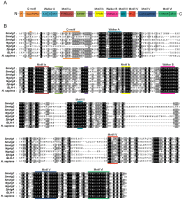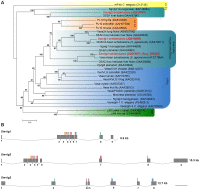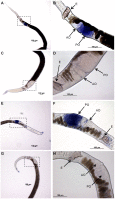Vasa-Like DEAD-Box RNA Helicases of Schistosoma mansoni
- PMID: 22720105
- PMCID: PMC3373655
- DOI: 10.1371/journal.pntd.0001686
Vasa-Like DEAD-Box RNA Helicases of Schistosoma mansoni
Abstract
Genome sequences are available for the human blood flukes, Schistosoma japonicum, S. mansoni and S. haematobium. Functional genomic approaches could aid in identifying the role and importance of these newly described schistosome genes. Transgenesis is established for functional genomics in model species, which can lead to gain- or loss-of-functions, facilitate vector-based RNA interference, and represents an effective forward genetics tool for insertional mutagenesis screens. Progress toward routine transgenesis in schistosomes might be expedited if germ cells could be reliably localized in cultured schistosomes. Vasa, a member of the ATP-dependent DEAD-box RNA helicase family, is a prototypic marker of primordial germ cells and the germ line in the Metazoa. Using bioinformatics, 33 putative DEAD-box RNA helicases exhibiting conserved motifs that characterize helicases of this family were identified in the S. mansoni genome. Moreover, three of the helicases exhibited vasa-like sequences; phylogenetic analysis confirmed the three vasa-like genes-termed Smvlg1, Smvlg2, and Smvlg3-were members of the Vasa/PL10 DEAD-box subfamily. Transcripts encoding Smvlg1, Smvlg2, and Smvlg3 were cloned from cDNAs from mixed sex adult worms, and quantitative real time PCR revealed their presence in developmental stages of S. mansoni with elevated expression in sporocysts, adult females, eggs, and miracidia, with strikingly high expression in the undeveloped egg. Whole mount in situ hybridization (WISH) analysis revealed that Smvlg1, Smvlg2 and Smvlg3 were transcribed in the posterior ovary where the oocytes mature. Germ cell specific expression of schistosome vasa-like genes should provide an informative landmark for germ line transgenesis of schistosomes, etiologic agents of major neglected tropical diseases.
Conflict of interest statement
The authors have declared that no competing interests exist.
Figures




Similar articles
-
Functional analysis of vasa/PL10-like genes in the ovary of Schistosoma mansoni.Mol Biochem Parasitol. 2020 Mar;236:111259. doi: 10.1016/j.molbiopara.2020.111259. Epub 2020 Jan 17. Mol Biochem Parasitol. 2020. PMID: 31958469
-
Cloning, Characterization, and Expression Analysis of the DEAD-Box Family Genes, Vasa and PL10, in Pacific Abalone (Haliotis discus hannai).Genes (Basel). 2025 Mar 11;16(3):329. doi: 10.3390/genes16030329. Genes (Basel). 2025. PMID: 40149480 Free PMC article.
-
Progress with schistosome transgenesis.Mem Inst Oswaldo Cruz. 2011 Nov;106(7):785-93. doi: 10.1590/s0074-02762011000700002. Mem Inst Oswaldo Cruz. 2011. PMID: 22124549 Free PMC article. Review.
-
Germline transgenesis and insertional mutagenesis in Schistosoma mansoni mediated by murine leukemia virus.PLoS Pathog. 2012;8(7):e1002820. doi: 10.1371/journal.ppat.1002820. Epub 2012 Jul 26. PLoS Pathog. 2012. PMID: 22911241 Free PMC article.
-
Building RNA-protein germ granules: insights from the multifaceted functions of DEAD-box helicase Vasa/Ddx4 in germline development.Cell Mol Life Sci. 2021 Dec 18;79(1):4. doi: 10.1007/s00018-021-04069-1. Cell Mol Life Sci. 2021. PMID: 34921622 Free PMC article. Review.
Cited by
-
Assessment of reference genes at six different developmental stages of Schistosoma mansoni for quantitative RT-PCR.Sci Rep. 2021 Aug 19;11(1):16816. doi: 10.1038/s41598-021-96055-7. Sci Rep. 2021. PMID: 34413342 Free PMC article.
-
Pseudotyped murine leukemia virus for schistosome transgenesis: approaches, methods and perspectives.Transgenic Res. 2014 Jun;23(3):539-56. doi: 10.1007/s11248-013-9779-3. Epub 2014 Jan 29. Transgenic Res. 2014. PMID: 24474164
-
Cell repertoire and proliferation of germinative cells of the model cestode Mesocestoides corti.Parasitology. 2022 Sep;149(11):1505-1514. doi: 10.1017/S0031182022000956. Epub 2022 Jul 5. Parasitology. 2022. PMID: 35787303 Free PMC article.
-
Septins of Platyhelminths: identification, phylogeny, expression and localization among developmental stages of Schistosoma mansoni.PLoS Negl Trop Dis. 2013 Dec 19;7(12):e2602. doi: 10.1371/journal.pntd.0002602. eCollection 2013. PLoS Negl Trop Dis. 2013. PMID: 24367716 Free PMC article.
-
The retinoic acid family-like nuclear receptor SmRAR identified by single-cell transcriptomics of ovarian cells controls oocyte differentiation in Schistosoma mansoni.Nucleic Acids Res. 2025 Feb 8;53(4):gkae1228. doi: 10.1093/nar/gkae1228. Nucleic Acids Res. 2025. PMID: 39676663 Free PMC article.
References
-
- King CH, Dickman K, Tisch DJ. Reassessment of the cost of chronic helmintic infection: a meta-analysis of disability-related outcomes in endemic schistosomiasis. Lancet. 2005;365:1561– 1569. - PubMed
-
- Rollinson D. A wake up call for urinary schistosomiasis: reconciling research effort with public health importance. Parasitology. 2009;136:1593– 1610. - PubMed
Publication types
MeSH terms
Substances
Associated data
- Actions
- Actions
- Actions
Grants and funding
LinkOut - more resources
Full Text Sources

